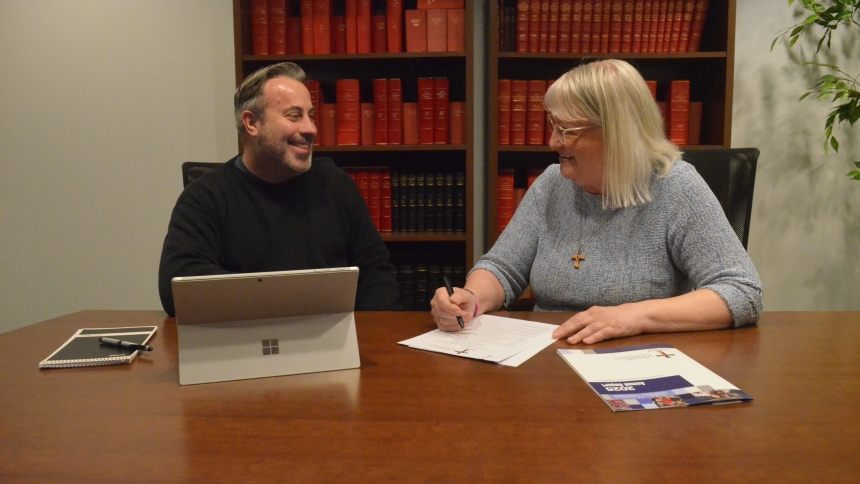
As published in the Northwest Indiana Catholic on February 10, 2019
I have always had a deep devotion to the Blessed Virgin Mary and to the Rosary, which was instilled in me by my parents from a very young age. About 15 years ago, I consecrated myself to Mary, utilizing the methodology of St. Louis de Montfort; this consecration is really a deep renewal of our common baptismal promises. This past year, however, my awareness of the Blessed Virgin Mary as an active force in my life has deeply intensified; I feel her presence, prayers and power in new ways that have been life-changing.
As Catholics, we have a rich theological appreciation for the Mother of God and her role in God’s plan of salvation. We honor her as the first believer in the Good News, the handmaid of the Lord who places her entire existence at the disposal of God. Mary’s surrendering fiat is the door through which God enters into our human flesh and saves us in Christ through our own experience and reality. Mary gives God a human face!
In his book, “Jesus and the Jewish Roots of Mary,” Brant Pitre explores the meaning of the title, “Ark of the Covenant,” an ancient appellation already given to Mary in the early Church. The original Ark of the Covenant was the ornately embellished box, constructed in the wilderness at the command of Moses, which contained the stone tablets of the Law given by the Lord on Mount Sinai.
Carried by the Israelites in their desert journey to the Promised Land, the ark was the dwelling place of God in their midst and was often overshadowed by the cloud of God’s glory. In his research, Pitre discovered that the same word for “overshadow” used in the Old Testament, “episkiazo.” in reference to God’s glory cloud visible above the ark, is also the word used for the overshadowing of the Holy Spirit in the Annunciation narrative when Mary conceives Jesus.
A second connection between the Ark of the Covenant and the Blessed Virgin Mary is the parallel language used in the account of King David retrieving the Ark of the Covenant from Judea and Mary’s visit to her cousin Elizabeth.
“David arose and went to the hill country of Judah to bring up the ark of God,” (2 Samuel 6:2) is parallel language to “Mary arose and went into the hill country of Judah to visit Elizabeth.”(Luke 1: 39) David admits his unworthiness to receive the Ark by exclaiming, “How can the Ark of the Lord come to me? (2 Samuel 6:9), as Elizabeth admits her unworthiness to receive Mary by exclaiming, “And why is this granted to me, that the mother of my Lord should come to me?” (Luke 1: 43)
David leaps before the Ark in joy, as John leaps in the womb of Elizabeth. The Ark remained in the hill country for three months as Mary remained in the hill country for three months.
In this Scriptural analysis, we clearly understand that the Virgin Mary becomes the definitive ark or tabernacle of God’s glorious presence in the world, beautifully manifested in Jesus Christ. The Council of Ephesus named her “Theotokos,” literally “God-bearer,” both as an articulation of Jesus’ divinity and the unique role of Mary in the salvation of the world. Mary carries that hope and promise in an ultimate fashion at the foot of the cross where she stands as a sentinel of love and resurrection in the midst of the crushing darkness of the crucifixion.
When all seemed lost, when Christ was dead, Mary dared to believe and trust once again in a mystery of ultimate grace and power beyond human comprehension.
At the foot of the cross, Mary received us as her spiritual children when Jesus entrusted John the Apostle to her as a son. Because Jesus’ death and resurrection binds the baptized as children of God to each other as brothers and sisters of the Lord, Mary becomes our mother. This spiritual truth has profound implications because we can now drink in the abundance of Mary’s maternal love, intercessory power and calming presence in our lives. She will teach us how to believe, surrender, trust, hope and sacrifice, as we grow in imitation of her Christian discipleship.
This past year, I have discovered the grace to pray the Rosary with more focus, imagination and awareness. This meditative prayer can become monotonous and empty if we are not careful, but when we pray it well, the Rosary is a daily encounter with the fundamental mysteries and saving events of our Christian faith.
Calling on Mary brings me to a felt knowledge of her actual and living presence in the joys and sorrows of my life as it is unfolding today. I can lay the events and experiences of my life over the narrative of Christ, finding meaning and hope in the knowledge that the life, mission and love of the Lord continues in each of our human stories. In all of this, the Mother of God walks with us, loves us, protects us and guides us to follow Christ and put his saving teachings into action.
Some theologians argue that Marian devotion is a needed feminine balance to an understanding of God and the Scriptures, which can often be very masculine. I would sum it all up by saying we all need a mother who will love, nurture, protect and bless us in the spiritual realm. In his infinite love for us, Jesus gives us the Blessed Virgin Mary as a sure protector, intercessor and guide in our pilgrimage to the Father’s house.
+ Donald J. Hying


